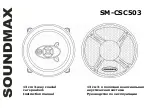
Thank you for purchasing a Nady WA 120 Wireless Portable P.A.—and
congratulations on your choice. The WA 120 is the most affordable
and compact of the popular line of Nady wireless P.A.’s. Ideal for
many applications, including use in classrooms, conference/meeting
rooms, churches, health clubs and small auditoriums, it is powerful, yet
lightweight and easily portable. We are sure you will find this versatile
system a powerful and useful tool for your presentations.
The Nady WA 120 includes a full-range speaker system with built-in
amplifier, mixer, and high band VHF wireless receiver. Special features
include:
• Wireless system features noise reduction companding circuitry for
quietest operation with a wide dynamic range.
• Built-in echo/reverb
• Available with choice of WHT handheld mic or WLT lavalier/headset
mic bodypack transmitters. One WA 120 wireless P.A. and one
WHT or WLT Transmitter on the same channel comprise a system.
• Powerful 20W audio output
• 1/4” unbalanced input jacks (1 MIC, 1 AUX) and one 1/4” unbalanced
RECORD OUT, treble and bass controls
• Powered externally with provided AC adapter, or internally with either
the optional RB-120 rechargeable battery or 8 “D” Cell alkaline or
rechargeable batteries
• Convenient internal charging ports for 9V rechargeable transmitter
batteries (NiCad or Ni-MH) and RB-120 optional rechargeable battery
• Small and lightweight—only 8.3” x 10.6” x 5.4” (211 x 270 x 137mm)
and 5.3 lbs. (2.4 Kg)
INTRODUCTION
Transmitter Set-up and Operation
• Snap open the
battery compartment (1)
and insert a fresh
9V battery
(2)
, observing the correct polarity. Close the compartment.
• The WLT is provided with a
3.5 mm locking jack (3)
for connecting
themicrophone. Plug in either the
Lavalier/Lapel (4)
or the
Headworn
microphone (5)
, as supplied. To secure the connection, turn the metal
slip ring on the plug clockwise to thread it on to the jack. To unplug,
reverse the process. Slip the transmitter into a pocket or clip on to your
clothes. To use the lavalier mic, attach it at chest level. Do not place too
close to the mouth – a distance of about six inches usually works best.
To use the headworn mic, place it on the head and adjust the mic boom
so that the mic is about one inch to the side of the front of the mouth.
(Note: The lavalier or headworn mic wire is also the transmit antenna,
and rolling up or shortening the wire may reduce the effective operat-
ing range. Extend the wire fully during use, and keep it as straight as
possible.)
• Turn on the WLT by sliding the
OFF/STANDBY/ON SWITCH (6)
to the
STANDBY position (transmitter on, audio muted) or the ON position
(transmitter and audio both on). The
battery indicator LED (7)
will give
a single quick flash, indicating usable battery strength. In the case of a
dead or low battery, the LED either will not go on at all or will stay on
continuously, indicating that the battery should be replaced with a fresh
one.
• The RF ON light on the WA 120 should now be lit.
• Re-position the microphone farther from the source or adjust the
audio
input level control (8)
if the monitored volume is to loud or distorted
after adjusting the receiver.
• Adjust the volume control of the WA 120 to a comfortable listneing level
as desired.
[Note: Observe care in selecting volume, transmitter location and
speaker placement so that acoustic feedback (howling and screeching)
will be avoided. Please also observe the pickup patterns of the micro-
phone selected: omnidirectional mics pick up sound equally from all
directions and are prone to feedback if not used carefully. Unidirectional
mics are more resistant to feedback, but pick up sound sources best that
are directly in front of the mic. Also, mics that are farther from the sound
source, such as lavaliers, require more acoustic gain and thus are also
more prone to feedback than close-source mics such as handheld or
headworn mics that are used close to the mouth.]
(Note: Microphone elements can easily be destroyed by the buildup of
salts and minerals from perspiration and saliva. It is good practice to put
a windscreen on the mic element at all times to protect it.)
2
11
Summary of Contents for WA-120
Page 2: ......

























